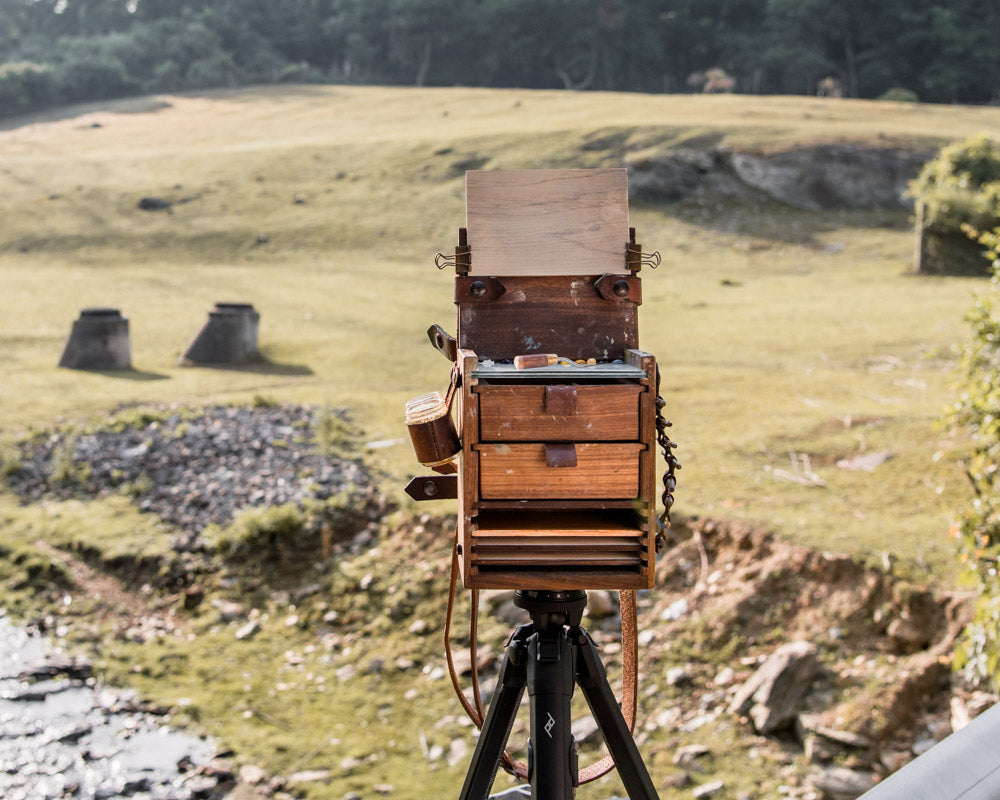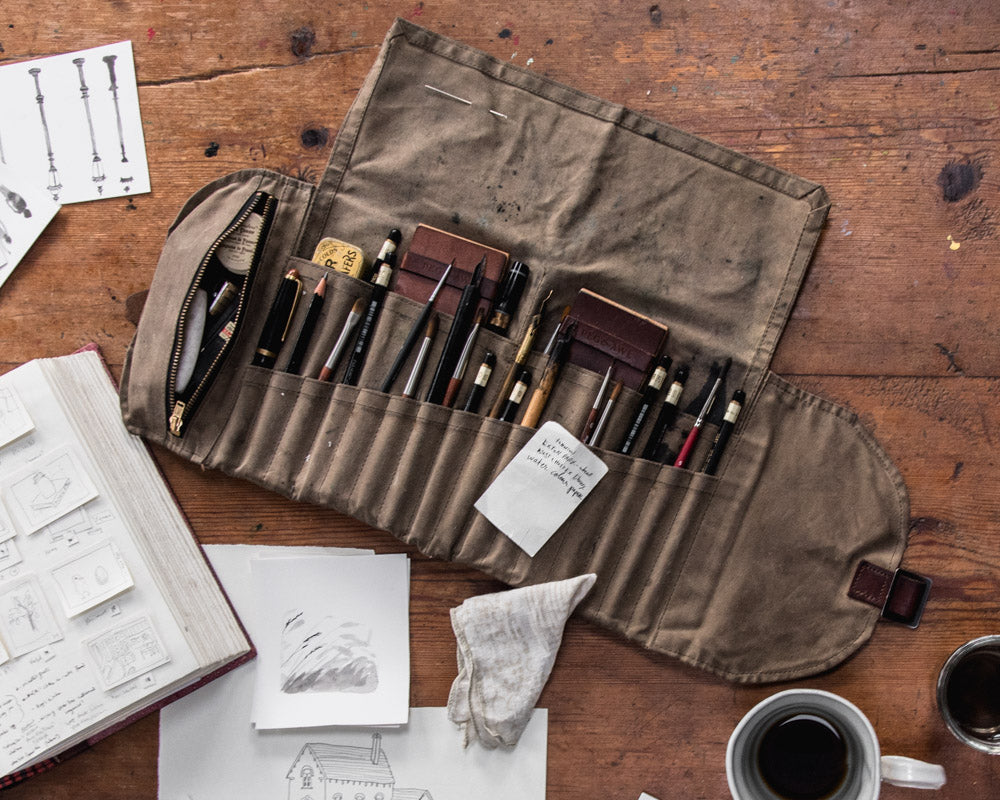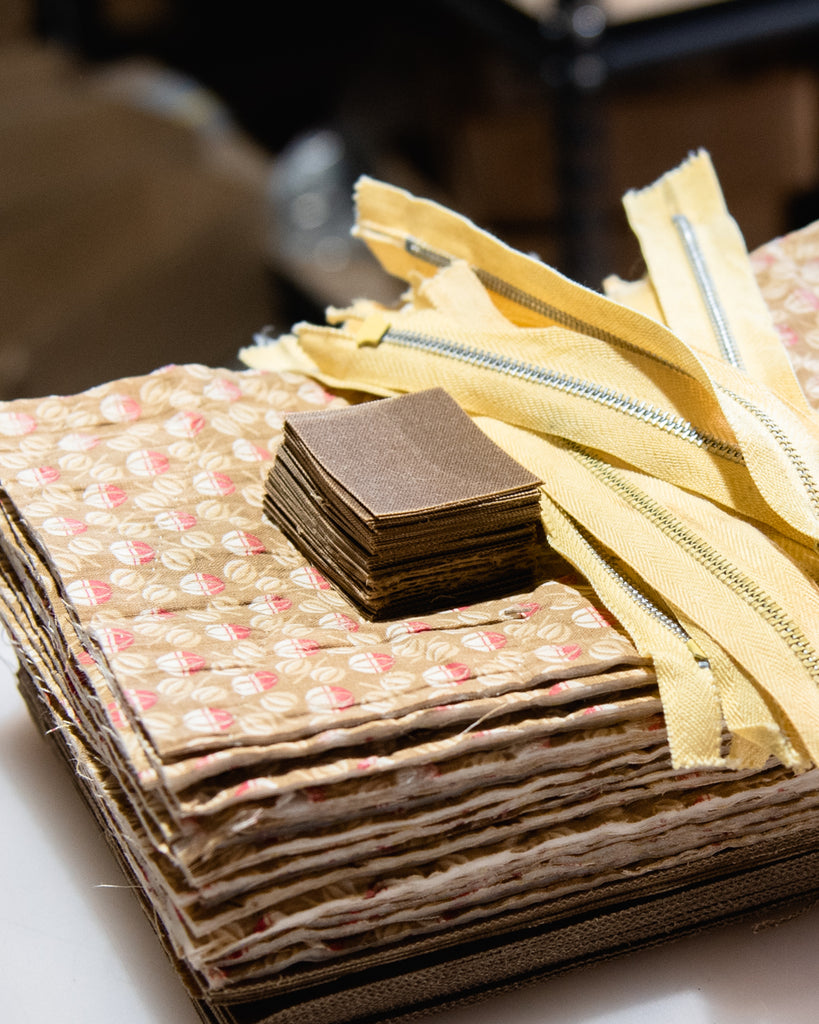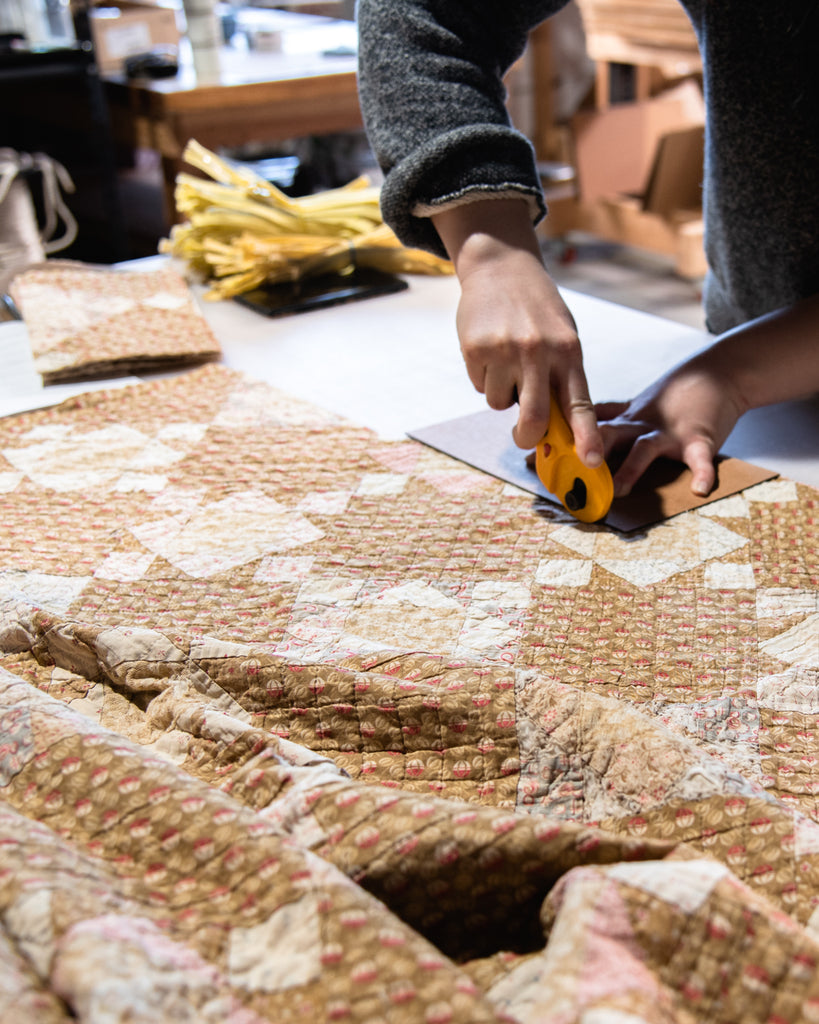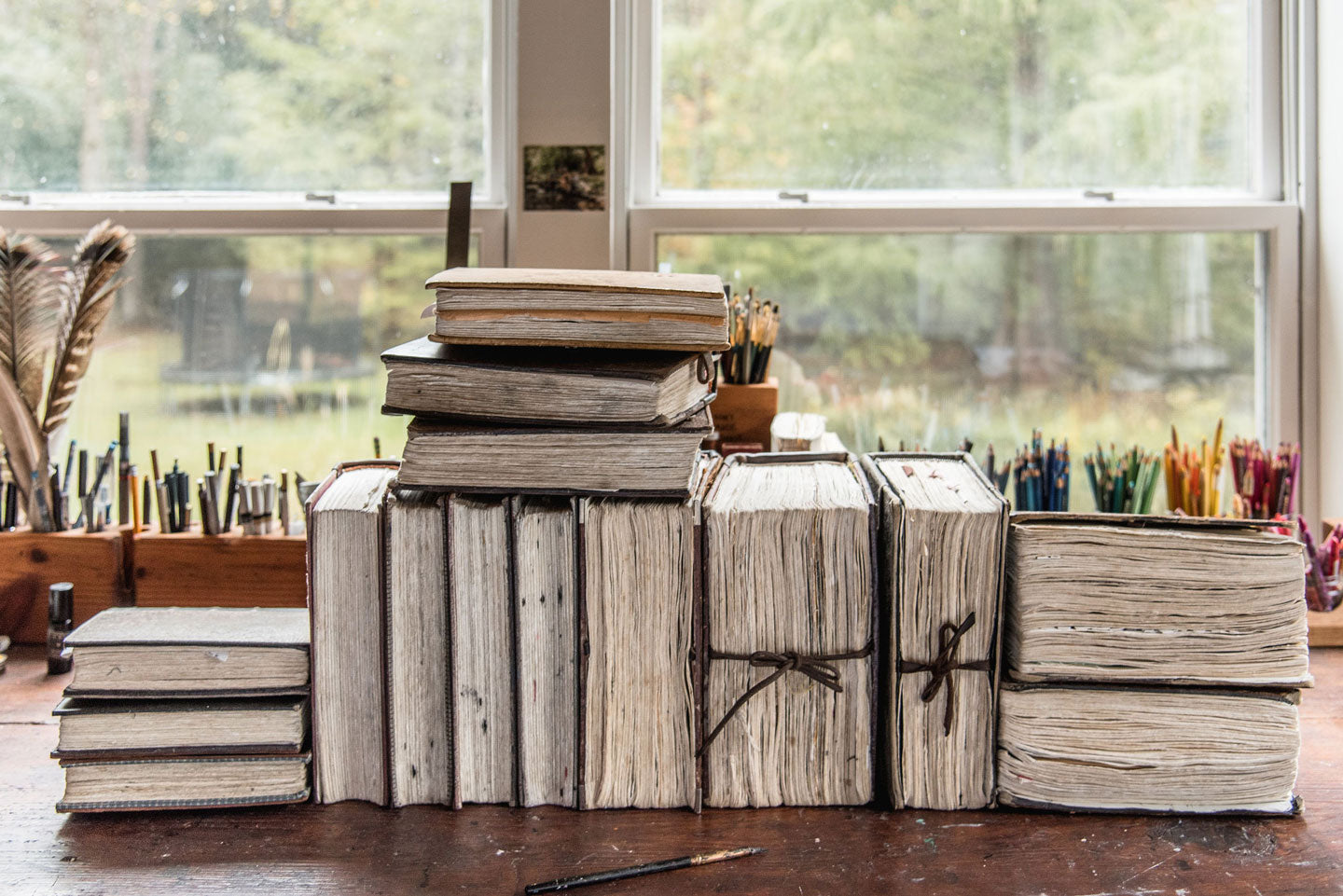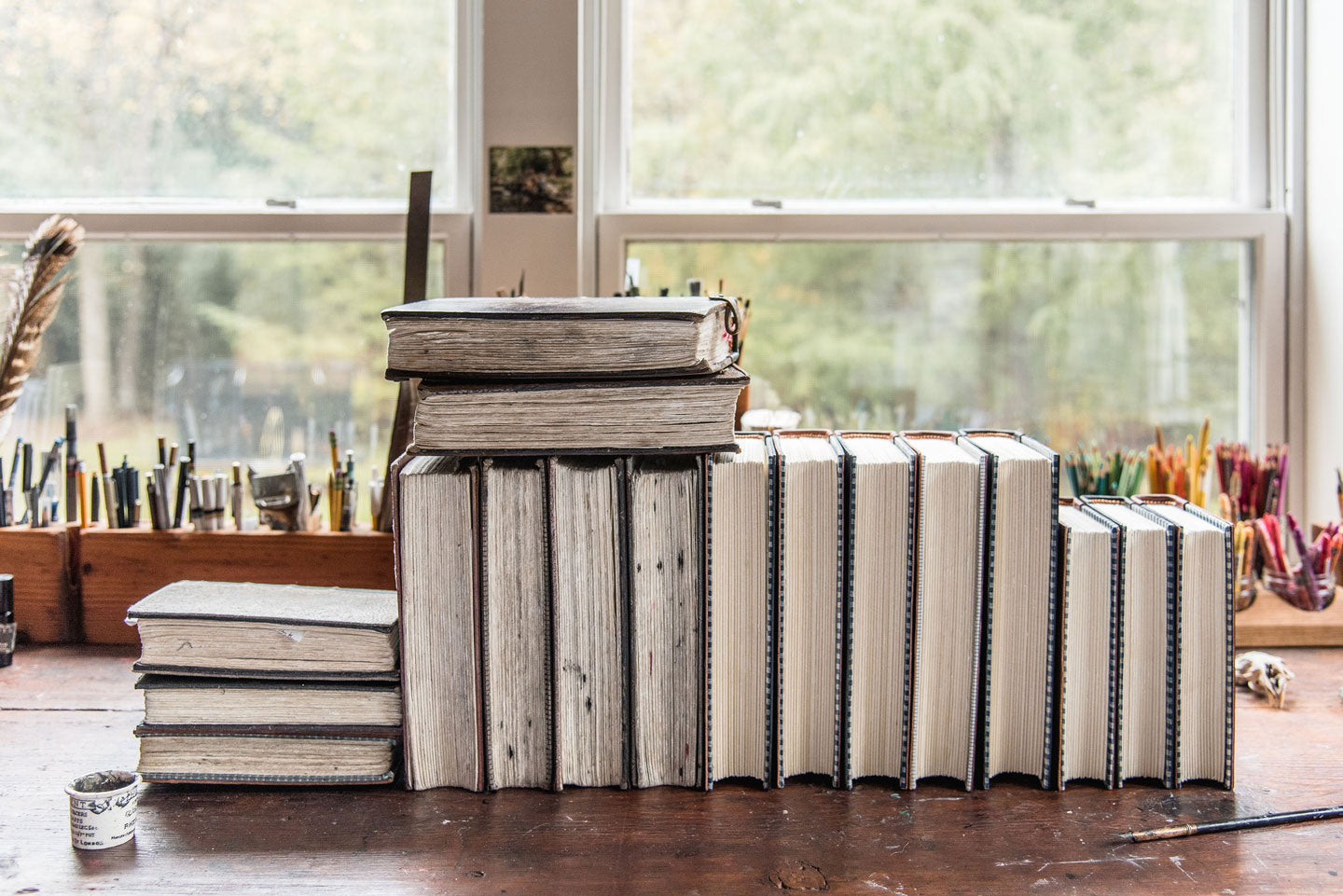Blog
How to Make a Hardcover Book with Vintage Materials
I love making journals and all kinds of books to fill up. To be clear, I make them to fill them. I am not a blank book collector. My books...
Read The Post-

“The world is indeed full of peril and in it there are many dark places. But still there is much that is fair. And though in all lands, love is now mingled with grief, it still grows, perhaps, the greater.”
―J.R.R. TolkienA story from Walter.
A month before our trip, a visitor – avid hiker, world traveler, adventure seeker – came to the Peg and Awl shop. He talked about different life-altering travel experiences and, after a few epic tales, his worst hiking trip ever – three days of cold, wet, isolating misery on the Presidential Range Traverse in the White Mountains, New Hampshire. It’s a fifty mile stretch of earth with a trail carved out heading straight up some of the rockiest terrain on the East Coast. The trail serpentines up and down the summits of each peak in the range through dense moss-covered conifer forest and into the alpine zone.
All of this sounded amazing: rocky crevasses, secret waterfalls, mysterious forests, and sweeping views of gradient blue steadfast giants erupting from the earth. But these formidable mounds of rock took up residence in the world’s most unpredictable weather. With extreme mood swings, the sky lavishes its energizing sun upon hikers one moment and the next it envelops the peaks with fog so thick fellow travelers who were only a step apart walk adrift, lost. A warm 80° day can plummet into the single digits with several feet of snow along with it. This range, with all its majesty, has engulfed many adventurers, taking their lives. It stands as a reminder to tread intentionally as we have no control over awakening the beast. All we can do is study its movements, measure its barometric pressure, test its air quality, and hypothesize about its intentions.
We were already aware of the range’s reputation but as we drove closer to New Hampshire towards the White Mountains and our very possible doom, our excited worry was bolstered by the strangers first-hand cautionary tale.
Little did we know that we were in for three glorious days.
The Scout Plein Air Box goes on every adventure!
The Ascent
Our ascent began in the dense moss-covered forest bursting with life. Green erupted from the earth filling every seam and overflowing into the path. The dark soil, white pine, balsam fir, birch, mountain ash, trillium, bunchberry, moss, and many small flowering plants flourished together, inviting us further up, further in. Like a temptress the forest pulled us close and let us drink in all its beauty and too hastily let go as we climbed into the boreal and alpine zones. Stubborn, crotchety krummholz spruce and fir replaced the greenest green. Trees and rock seemed to turn on one another in the great battle of survival. The rocks gained the upper hand the higher we climbed until the trees retreated completely and let the sedges, grasses, and Diapensia carry on the fight. The guides warned us to step cautiously for if we trampled the smallest bit of alpine plants it would destroy one hundred years of growth. We found our footing on the steep rocks and scrambled up.

The Ammonosauc River

Tiny worlds full of life

Diapensia, a very slow growing plant

Emerging from the boreal zone

Ever upward

Our first glimpse of the Lakes in the Clouds Hut
The Lakes in the Clouds
Suddenly our destination sprang into sight, The Lakes in the Clouds, a wood shingled hut that could sleep and feed 92 adventurers. One of eight huts dotting the mountain range like stars in a constellation, it was built in the 1880s and has been a continual refuge for hungry and weary travelers. Ten caretakers were garrisoned there maintaining the building, cooking meals, and researching the plant growth, insect world, and weather patterns. Twice a week they carried food and supplies in on their backs, strapped to oak ladder boards marked with the names and initials of past caretakers. Loaded up with 60-100 lbs of supplies they navigated the steep rocky traverse to the huts.
A small self-contained community hummed inside each wood paneled hut. Energy was extracted from the sun, water from the ground, waste composted and the message of leave no trace was shared with all who passed through. Each choice was intentionally made to create a minimal impact while enjoying the perilous and beautiful White Mountains. Come evening, we listened eagerly to the weather report – the one thing that would dictate our plans for the next 12 to 24 hours.
Our safety depended on it.
Photographs by Silas

Our home for one night

The Lakes of the Clouds hut is nestled in just below Mount Washington
Three Glorious Days
We spent our three days exploring this majestic part of the world, painting, drawing, playing cards, conversing with our guides, and laughing a lot. We learned about plants and animals and heard stories of the Crawford family, pioneers in guiding hikers though this rough terrain. We watched the sun set and saw clouds glide over the ridge as we hiked. Our hats flew off in the wind, and we were absorbed by the dense fog. There were murmurings of ferocious thunderstorms but instead we were graced with rejuvenating rain and one of the largest rainbows I have ever seen. That’s the thing about peril, it doesn’t always end in doom. The unpredictability forces us to give up control and appreciate the the good times. It reminds us that beauty and impermanence are inseparable and like complimentary colors, they make their counterpart more vivid, more alive! With Robert Frost’s Nothing Gold Can Stay flowing though my mind we hiked down and out. Farewell to the mosses, the flowers, the trees. Farewell to the mountains, but hopefully not for long.
Painting at Mizpah Spring Hut

The Hawkweed was amazing!

A rocky descent!

Hiking the ridge toward Mizpah Spring Hut
Wildland Trekking
This is my second trip with Wildland Trekking, a company whose goal is to inspire people and enrich their lives through experiencing the wonders of our amazing planet.

Trekking into the unkown

The oak ladder board

Hearty yet fragile alpine plants
Presidential Range Traverse
“The world is indeed full of peril and in it there are many dark places. But still there is much that is fair. And though in all lands, love is...
Read The Post
Product Care and Tutorials
-
One of the key steps to speed up the breaking in process of leather is to simply twist and roll the leather in your fingers. As you use your bag the leather will naturally soften and become much easier to maneuver. Whether you help it out, or simply use your bag, the breaking in process does not take long!!
*What is Vegetable Tanned Leather? Vegetable tanning is a slow, natural, and sustainable process of tanning raw hides with natural, biodegradable extracts derived entirely from vegetable sources such as tree bark.
Our bags are made with full-grain vegetable-tanned leather*, which is a durable leather that develops a lovely patina over time with continued use. It is thicker than conventional, chrome-tanned leather, which also lends it to be more stiff in the beginning. This video shows how to quickly soften the leather, as well as the proper steps for detaching and attaching the leather shoulder strap and front closure on our Peg and Awl bags.
One of the key steps to speed up the breaking in process of leather is to simply twist and roll the leather in your fingers. As you use your bag the leather will naturally soften and become much easier to maneuver. Whether you help it out, or simply use your bag, the breaking in process does not take long!!
*What is Vegetable Tanned Leather? Vegetable tanning is a slow, natural, and sustainable process of tanning raw hides with natural, biodegradable extracts derived entirely from vegetable sources such as tree bark.
Step 1: Detaching the Strap
*The leather is the most stiff when it is new. As you use it and work with it, it will soften.- Hold the button stud and pull the leather strap to bring the button stud into the leather slot.
- Firmly and slowly work the leather over the button stud. Take your time working with the leather as it softens.
Step 2: Attaching the Shoulder Strap-
Twist and roll the strap to soften the leather. It does not take long to break in.
-
Press the leather slot over the button stud. Hold the stud and pull the leather strap to bring the stud into the hole.
Our Leather!
Our first bag – The Waxed Canvas Tote – which we finished with reclaimed military leather slings found at a flea market. Dusty and dull with years of neglect, the leather was unassuming. But with some hot soapy water, perseverance, and beeswax balm, we removed the layers to find stories told through the markings of days past. We were delighted! The usefulness of the leather sent us on a mission to scour flea markets and military shows for as many old slings as we could find. For years we used these relics to finish our bags – until there were no more to be found.
And so, a new mission was soon underway: the search for the right new leather. We began in the UK driving along long and winding roads through the English countryside to visit J&FJ Baker, a 500-year-old tannery. This experience and many subsequent conversations enriched our understanding of a leather world we had known nothing about.
While shipping leather from the UK turned out to be impractical, we left enlightened with the knowledge that there do exist a few companies who produce leather in a sustainable and responsible way. When we returned to America we found Wickett & Craig – only a stone’s throw from our shop in Philadelphia. Their vegetable tanning process is a slow, natural, and eco-friendly process of tanning raw hides with natural, biodegradable extracts derived entirely from vegetable sources such as tree bark. This durable leather breaks in and gathers a gorgeous patina, bearing the marks of the users’ (and makers’) adventures – the very thing we’ve always celebrated! We’ve been using this leather for three years now and love it!
With the transition from using reclaimed WWII era gun straps for our leather handles to using locally-sourced vegetable-tanned leather, we are reaffirming the fellowship between ourselves and the materials with which we make. By creating beautiful and useful objects out of sustainable and responsibly sourced materials, we strive to change the way that we as individuals make, use, repair and reuse everyday objects. As our new bags leave our Philadelphia workshop and arrive at your doorsteps, what adventures will they see in your hands and how will they transform to become truly yours?


Vegetable tanned leather is made with a slow, natural, and sustainable process of tanning raw hides with natural, biodegradable extracts derived entirely from vegetable sources such as tree bark. The more you use your bags and journals, the softer the leather will become. 

This durable leather breaks in and gathers a gorgeous patina, bearing the marks of the users’ (and makers’) adventures! Here, you can see the leather on Walter's Tote and Scout. As you use your bag the leather will naturally soften and become much easier to maneuver. 

We took out Hunter's out on an Amethyst dig! they got pretty dirty, so we turned the bags inside out, tapped out the dirt and wiped the inside with a sponge and put them in the sun to dry. Our Finch is my favourite bag - I carry mine nearly everyday. It holds my books, journal, water bottle, and other bits comfortably. Adjusting the Leather Straps on our Waxed Canvas Bags
One of the key steps to speed up the breaking in process of leather is to simply twist and roll the leather in your fingers. As you use your bag...
Read The Post
-
The Sendak Artist Roll: A Walkthrough Video
We’ve watched all of the YouTube reviews of our Sendak Artist Roll (thank you!) and have made our own video to answer some questions and share our experience! We are...
Read The Post
Press
-
Press: Cultivating Place Podcast
Cultivating Place: Natural History & Our Gardens The Adventurous Art of Cultivating Place, with Peg & Awl
Read The Post -
Press: Leslie Stroz
Scout Plein Air Box Review The Sendak Artist Roll Review More Leslie Stroz Videos Featuring Peg and Awl! Rating ALL of My Travel Watercolor PALETTES (the BEST and WORST) BEST...
Read The Post
-

The first abandoned house I remember exploring was across from the grocery store my mom and I skipped to, arm in arm, when I was in 7th grade. We had seen its decaying Victorian turrets peeking above the abundance of neglected foliage many times before braving its withered threshold. Early one Spring, we ventured into that liminal space and I don't believe I ever completely left. Inside reeked of piss and mildew. Broken bottles and yellowed newspapers made a foul floor for weekend teenagers. But in the center – beneath a makeshift skylight and its funnel of wintry, warm, yellow sun – grew a single white tulip. Discovering this unexpected beauty with my mom so long ago, was surely a heavy pour in the cocktail of experiences from my youth that helped determine who I was to become.

The first abandoned house I remember exploring was across from the grocery store my mom and I skipped to, arm in arm, when I was in 7th grade. We had seen its decaying Victorian turrets peeking above the abundance of neglected foliage many times before braving its withered threshold. Early one Spring, we ventured into that liminal space and I don't believe I ever completely left. Inside reeked of piss and mildew. Broken bottles and yellowed newspapers made a foul floor for weekend teenagers. But in the center – beneath a makeshift skylight and its funnel of wintry, warm, yellow sun – grew a single white tulip. Discovering this unexpected beauty with my mom so long ago, was surely a heavy pour in the cocktail of experiences from my youth that helped determine who I was to become.
Three years ago, just one year after officially beginning our homeschool adventure with Søren and Silas, we decided to move out of Philadelphia in search of a new home amongst the trees. We quickly stumbled upon the patch of land that we’ve come to call The Five Acre Wood – consisting of a ton of invasive growth, some lawn, woods, ponds, animals, two creeks, our house (built in the late 1700s or early 1800s), a spring house (formerly our studio) and – just across the road – a dilapidated barn. Truly, our timing was perfect.


The Old Barn from the road. We hired Precise Buildings to rebuild the barn! In the listing Walter had spied a corner of the barn – a cautious partial revealing of this daunting danger for most, we reckoned, and possibly the reason the house had been on the market for so long. But we dreamed of transforming the barn into a studio for art, homeschooling, woodworking, and yoga. Two years after our move, with the sale of our Philadelphia home (previously serving as an Airbnb), we were able to embark on this new adventure.
The project began with the removal of decades – centuries even – of junk that had been accumulating. We briefly considered hauling the stuff to a flea market to help fund the barn restoration, but after moving some of it out (there was so much!) we ordered a dumpster, and set everything curious in rows in the grass for the taking. There were chairs, well-loved ice skates, wooden sleds, tons of old bottles and antique toys – and then came the people – making it a strange theatre. The conversations that arose during the treasure-dispersal resulted in many journal pages of quotidian conversations which reveal people to be anything but the perceived everyday.


Most of these strange treasures found homes... The telephone operator thing went to a musician who plans to turn it into something musical. After the emptying, came the digging of an incredibly deep well which resulted in the grinding and unexpected excavating of Wissahickon Schist – also known as trash stone – from which our house was built. I collected a salad container full and transformed some of the pre-ground pigment into paint for my Iris Painter’s Palette.


Look for Bioplastic Pans of this handmade watercolor paint in our First Of a Kind Collection of the Year! Wissahickon Schist — also known as Trash Stone — makes a gorgeous ghost green colour. We then removed the lead-free wood siding, the tin roof, the old doors, the flooring, and some beams, with the intention of re-using as much of this as possible in different places both inside of the barn and out. When the township inspector came and saw the rotted state of the exposed bits that were revealed, we had to embark upon a plan b, which brings to mind The Ship of Theseus.
By the time we finished removing the rotted bits, the trusses, the rafters, the floors, it was hard to say if we were reclaiming an old barn or building a new one in its image. The barn shape– the space within the frame – became one of the few parts I could solidly say remained of the historic place. But over the next few weeks – as I observed the delicate skeleton of the old barn standing strong but precarious in the wind and rain, with day now inside and night inside too – I grew suspicious of this boundaryless thing I wanted to keep. What were we preserving, and more, why?


Putting on a new roof before taking it off to remove more of the old. Delicate skeleton of the old barn. 

After getting over the long pause whilst figuring out plan b... A new view! Most of the structure is new now, but within it is a tapestry of old materials. Walter transformed the old extinct-ish American Chestnut tree trunk beams into two glorious sets of double doors. An old second floor door, which led to an unsurvivable drop, is now part of the bathroom. The old floorboards were flipped and trimmed and woven with old floorsboards from other barns, and together have been sanded and oiled. The crooked skeleton of hand-hewn wood with its mortise and tenon joints, trunnels, and roman numeral marriage marks, lingers charmingly in the middle of the new open space. The white-washed wall, that once held tobaggons, hockey sticks, and fishing poles still divides the two main spaces. The stone-walled basement, where the barn’s last farm animal – a calf – lived in the 1960s, will soon be a woodshop and ceramic studio. We put windows and skylights throughout the building, replacing the vertical cracks that let only slivers of light in for the past 200 or so years.
The shape within the frame remains, but the air that flowed through it like water through a river, has surely been fully turned over. Already, the newly brightened space has illuminated a life unimagined by the original builders, including family yoga, the beginning of a writing and drawing workshop, the penciling of portraits, the playing of boardgames, the making of maps, a happy Pearl and a sleepy Pearl, and the curiosity of two families embarking on new adventures. The barn is made of pieces that were and are and will be. Are we so different?


A Trunnel – one of many Tree Nails securing the original structure. Roman Numeral Marriage Marks to help builders determine what went where! 
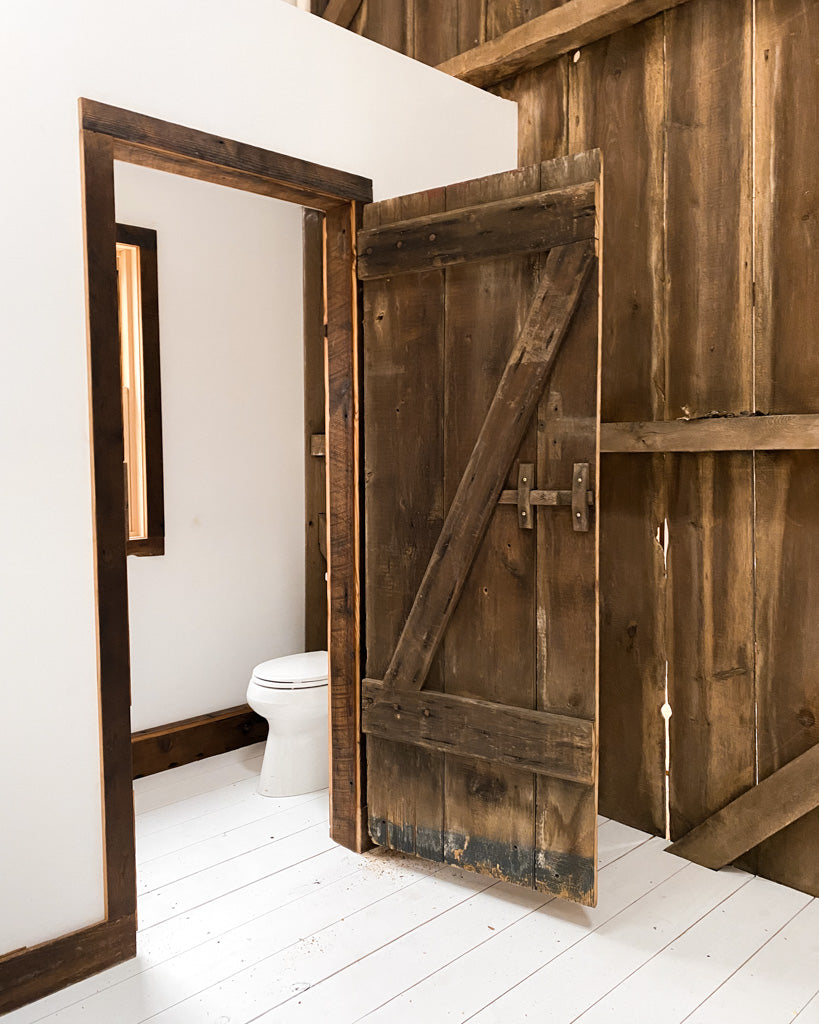
An exterior door that led to the unsurvivable drop, (that looks rather survivable from here...) ...is now our bathroom door! 

The Floor Sanders – Søren, Silas, and I — unintentionally recreating The Floor Scrapers by Gustave Caillebotte. The Floor Scrapers by Gustave Caillebotte 

A satisfying before and after! We first rented this Drum Floor Sander and used 60 grit sandpaper, then used this Orbital Sander with 80 and 100 grit. Finishing the new floor with Citrus Solvent and Tung Oil from The Real Milk Paint Company. We use this natural finish on Peg and Awl treasures too! 

Pearl enjoying the new space from her favourite rug – a flea market find! We painted the floor white! Søren tries out the new staircase that he helped install, 

Original wall that divides the two parts of the barn. Pearl and Søren, my loves. Walter used the saw mill to make doors out of the American Chestnut trunks! 

American Chestnut Tree beams born in the 1700s leave their lowly position of being walked upon + now usher in light, people, and animals! Walter’s gorgeous first go at door building! Peg and Awl Barn Restoration Project at the Five Acre Wood in Pennsylvania
The first abandoned house I remember exploring was across from the grocery store my mom and I skipped to, arm in arm, when I was in 7th grade. We had...
Read The Post -
The pileup is usually an effective way of moving us into high speed. We will open our barn doors tomorrow, for the first time, as a Peg and Awl storefront! It will also be filled with our art, which is most often squirreled away under our rounded bodies as we scribble, cut, or swish with whatever materials are at hand upon our pages.


Smudge and Other Pandemic Pages“If you like to write or draw or dance or sing, do it because it’s great: as long as we’re playing around like that, we don’t feel lonely, and our hearts warm up.”
–from The Woman Who Killed the Fish by Clarice LispectorI’ve been making books and filling them for as long as I can remember. The books pile up – a slow and steady drip of ink on paper that may someday push us out of our home. One of the gifts of the pandemic is a clear time frame. I’ve decided to go back into my journals – specifically, into the pandemic pages, to see what I could find. I found the patterns of our lives on repeat, everything obsessively documented as if we wouldn’t live without record of it. I found Pearl, and plants, grief and illness, disappearance and disappointment, homeschooling, camping, movement, and details so small I needed the quiet of a pandemic to experience them. It is a strange vocation, to be this kind of capturer of the quotidian.
“What is the conversation?” asks Claire, a few times. Conversation? I don’t know how to answer that. The conversation is on the pages, extracted from life, fragments rearranged, stories imagined, reimagined. Patterns, tatters. Is there ever an actual anything, or is everything imagined? There isn’t a conversation – there are infinite conversations and there are no conversations. It depends on who stands in front of what, and where. It depends on who is next to them. How engaged they are. How curious. It depends on what I say here, if anything, and whether you read it. Will you?
Just before the pandemic, I chose a word for the year, for 2020: The word was lightness. I wrote:
“My word for the year is lightness. I love this idea of finding a word to live alongside. So far, (so early but so far), it has freed me from the fear of not making the right marks. It has led me to say yes to a wintry adventure at the seashore where with wet knees and raisoned fingers, we searched for Cape May diamonds with the enthusiasm of children whilst the actual children played with drones, dipped their feet (and pants) into the frigid water, gathered a few specimens, and made their way back to the warm car. These are things that I love, but the weight of obligation and difference and the world’s expectations make it difficult to be so light. The more I forget this, the longer I sit. The longer I sit, the heavier I get – the weight of the dust settling upon me. Lightness. The word, my companion, reminds me to hover and to float – to move and to keep moving.”
It was the right choice, this word, and it came just in time.

From A Tear and A Seed A sneaky peek! 

The Things That I remember Are Not in These Photographs SMUDGE! Left-handed (non-dominant) hand drawings. A Tear and A Seed... drawings from a book I didn’t illustrate. A stack of my smudge journals! Our First Storefront!

“...the impeded stream is the one that sings.”
–from Our Real Work by Wendell BerryThe pileup is usually an effective way of moving us into high speed. We will open our barn doors tomorrow, for the first time, as a Peg and Awl storefront! It will also be filled with our art, which is most often squirreled away under our rounded bodies as we scribble, cut, or swish with whatever materials are at hand upon our pages.
We are still scrambling, but hope you come by and say hey! Email us for the address or find it at the Chester County Studio Tour website. Parking is limited – if ours is filled, park in the nearby neighborhood! If I have time, I’ll mow some roadside invasives for side-of-the-road parking.
Pouches! We have a new batch of A Rural Pen ink! Seaside Tote, Caddies, &c. Some of our Last Chance waxed canvas bags are in the storefront! 
New Prints from A Tear and A Seed (coming soon to our website, maybe...) We will stock our jewelry in this old treasure! Walter, Søren, and Silas!
We are still working and will share updates on Instagram!
Søren has been working on this gigantic map for months! Come see it in progress or on Instagram @sorenscoutkent
Everywhere, Astonishments!County Studio Tour 2023 | Peg and Awl
The pileup is usually an effective way of moving us into high speed. We will open our barn doors tomorrow, for the first time, as a Peg and Awl storefront!...
Read The Post
Bookbinding Tutorials
We have put together a long overdue tutorial on bookmaking. I have prepared a list of things you will need to make your first notebook. This is a very simple start—you can use materials that you have at home and anyone, any age can join in!
So, let’s make books!
-
Explore Our Tutorial Series to Bind Your Own Journal. You can use materials that you have at home, and anyone of any age can join in!
Photo by @holddear
Share your Peg and Awl with #quarantinebookbindingclub to be featured!


Bookbinding Tutorials
Read The Post -
So here we are again – still at home and pleased to share our next installment of our Bookbinding at Home series! We hope you have found some small things to enjoy in this time of truly slooooowing down. For me it is always the small things that brighten my days, like watching Toots and Yedda – our goose landmates – and transforming a pile of field stone into an elegant yet makeshift garden path!
As for the tutorials, we are learning a lot (we hope you are too) and are so grateful for everyone who is joining us!
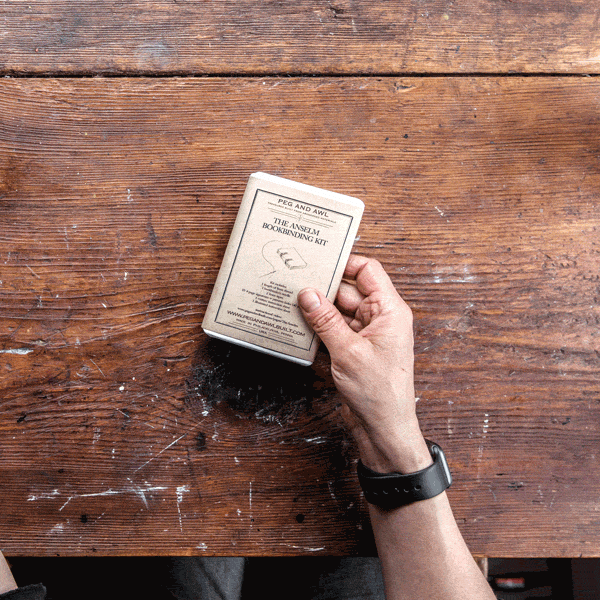

Bookbinding at Home: Part 2
So here we are again – still at home and pleased to share our next installment of our Bookbinding at Home series! We hope you have found some small things to enjoy in this time of truly slooooowing down. For me it is always the small things that brighten my days, like watching Toots and Yedda – our goose landmates – and transforming a pile of field stone into an elegant yet makeshift garden path!
As for the tutorials, we are learning a lot (we hope you are too) and are so grateful for everyone who is joining us!
Project No. 2: Stitching Signatures for a Coverless Sketchbook


Here is what you will need:
1. Needle – bookbinding needles have roundy tips and big eyes, but most needles will work!
2. Thread – any thread will do. If it is super thin, double it up.
3. Pencil – grab your favourite pencil to plot your stitching holes.
4. Paper – this is for the inside. Do you like lined paper, sketch paper, the back of used paper, graph paper? Gather your favourites, mix ’em up or stick to one!
5. Thumbtack – or something sharp to poke holes through paper and cardstock.
6. Scissors – for snipping your thread.
7. Fabric – this will serve as your linens that will hold the book together. Happy treasure hunting!
8. Glue – to glue your fabric to the front and back covers of your book. Elmers works!
We get most of our bookbinding tools and materials from Talas, including needles, thread, linen tape and other materials we haven’t explained yet. The waxed thread that I am using is a 3 ply waxed Irish Linen thread.
We love Strathmore drawing paper for our journals and find that and other supplies through Artist & Craftsman. Both the latter and Talas are small companies who have shut down their physical locations but are currently taking online orders and shipping!
As for covers, vintage textiles, needle boxes and vintage tools – you can find all kinds of unexpected magic at home as well as on Etsy and eBay. We at Peg and Awl absolutely encourage creativity in materials and tools, and finding vintage stuff is a nice way to reclaim some of the excess of items that already exist on our planet. This is also a way to make your project and your desk specifically yours!
Bookbinding Glossary
Sheet: The unfolded paper pages that you start your project with
Folio: A folded sheet
Signature: Gathering of folios
Leaf: One half of a folded sheet
Page: Each side of each leafPlease share your little books with us with hashtag #quarantinebookbindingclub – we’d love to see what you are making, and share the results!
The Next Step…
Continue on with our next bookbinding project: covering a coverless book! We will only be covering a book, so bring your coverless book from this project to the next installment.
And While You’re at Home…
If you are housebound or feeling antsy, there are oodles of projects online and on Instagram. I’ve found inspiration from The Good Ship Illustration’s drawing guide The Sketchbooker’s Friend. The first tip is pretty great:
NO PHONES. Don’t take a photo, then draw from it. Don’t finish your drawing at your desk later. It is NOT ALLOWED and we are very strict!
Bookbinding at Home, Part 2: How to Stitch a Coverless Journal!
Read The Post -
Here is the last video in our first bookbinding tutorial series: Bookbinding at Home. Thank you all for following along and sharing your books. We are so psyched to see all of the books that have come out of these tutorials!


Here is the last video in our first bookbinding tutorial series: Bookbinding at Home. Thank you all for following along and sharing your books. We are so psyched to see all of the books that have come out of these tutorials! We hope you find comfort in the process of binding your books as well as filling them. There is certainly a lot to document right now— in both pictures and words.
We love seeing your books and sharing in our Instagram stories and posts (@pegandawl) – be sure to use #quarantinebookbindingclub and/or #pegandawlbinds on your social media posts so we can find you!Project No. 3: Covering a Journal with Leather
Here is what you will need:
Leather – If you have scrap, an old jacket or wallet, anything soft and malleable, have it ready! Scraps of many colors are also available from many sellers on Etsy.
Fabric – This will replace mull (a starched cheesecloth) that will be glued directly to your book block to strengthen your book.
Thread – For the headband. Aim for something thick that will take up space. You can also use a pre-made headband.
Scissors – For trimming your cover. If you are using leather for your cover, make sure they are sharp!
Hammer – For shaping your book block. Be sure it is clean as it will be coming in contact with your paper! (I used a rock hammer and my pages don't hide it!)
Glue – For gluing your leather to the front and back covers of your book. Elmers works!
Heavy Book – This will be your book press! Any heavy book will do, though I find art books (and their dense pages) perfect for the job!Bookbinding at Home Part 3: Covering a Journal with Leather
Read The Post -
We’ve made another video installment to our Bookbinding Tutorials – this one is in response to all of the detailed questions you’ve been asking about our materials. I’ve also shared a little of my bookbinding history—where you can see my old falling apart journals as well as some insides and a variety of antique leather outsides!

We’ve made another video installment to our Bookbinding Tutorials – this one is in response to all of the detailed questions you’ve been asking about our materials. I’ve also shared a little of my bookbinding history—where you can see my old falling apart journals as well as some insides and a variety of antique leather outsides!
Chapters:
0:00 List of Materials
0:32 How Margaux Got Started Bookbinding
1:37 Margaux’s Early Journals
2:59 Overview of Materials
3:31 Thread
4:07 Needle
4:38 Tape
5:14 Headband
5:38 Mull
5:49 Glue
6:03 Cover
8:32 Paper
9:07 ConclusionBookbinding at Home Part 4: Materials and Meanderings
Read The Post
-
Our first Of A Kind Collection of 2022 is bursting with character! Each of these collections allows us to dig around and find treasures within treasures. Every discovery holds a bit of the past, and the story and marks accumulated. They are a joy to put together and harken back to the best part of our origin story – the gathering of old things and the reimagining and reworking of them into once again useful objects.

Our first Of A Kind Collection of 2022 is bursting with character! Each of these collections allows us to dig around and find treasures within treasures. Every discovery holds a bit of the past, and the story and marks accumulated. They are a joy to put together and harken back to the best part of our origin story – the gathering of old things and the reimagining and reworking of them into once again useful objects.
Hand Mulled Ghost Green Watercolour Paint!
We made two small batch sets for painters. The first is the Petite Paint Set, which contains a pan of hand mulled Ghost Green watercolour and a brush rest. The other is a set of 3 Brush Rests for those of you with more than one brush or pen in use!
Our watercolour is made from Wissahickon Schist that was pulverized when digging the well for our barn. Made from rock, the paint is gritty in texture, and a warm, earthy grey green. This paint is in Bioplastic Pans, made by Poems About You, that fit in our Painter’s Palettes.

Bioplastic pan of Ghost Green Watercolour. The Wissahickon Schist was pulverized when digging the well for our barn. 

Wissahickon Schist – also known as Trash Stone – makes this gorgeous ghost green colour. I transformed the pre-ground pigment into paint, which is part of our Of a Kind Collection! 
A page of my left-handed #100DayProject in my Anselm Sketchbook. Portrait of my family in Ghost Green. Printable: Paint Pan Packaging
We have made this paint packaging available so that you can package your own handmade paint. As it is, it is designed to wrap around the Bioplastic Pans by Poems About You, although you can adjust and be creative about your uses and sizing!
Handmade Brush Rest made from Reclaimed American Chestnut!
The Brush Rests (here in a trio) are made from extinct* American Chestnut beams that – for nearly 200 years – held up our barn (read about our barn restoration here). Walter turned them into barn studio doors and made these delicious little brush rests with the scrap – they fit perfectly in the Sendak pocket and may just make clean up a touch easier next time!
*Read more about the blight on the American Chestnut here.

Our Brush Rest, Hand Mulled Paint, and Tilda Painter’s Palette together! I’ve been using my brush rest also as a rest for my vintage dip pens, so we're also offering a Trio of Brush Rests! 

The barn – before restoration! These American Chestnut Tree beams, born in the 1700s, held up our barn for nearly 200 years. 

Walter used his Alaskan Saw Mill to mill down the beams. We’re excited to share a portion of this beautiful reclaimed wood in the form of brush rests! Mystery Boxes!
They are back! We’ve sifted through our misfits: merry mishaps, prototypes, and items riddled with character – imperfect but fully functional. We’ve have grouped them together into themed mystery boxes at nearly half price! Though not for the faint-hearted, each set is useful and nearly half price. Enjoy the mystery and the gifting potential: one for you, one for me, one for you...
These boxes are perfect for the indecisive (who love Peg and Awl) or for those who just love a good mystery. The Desk Caddies more character, knots, holes and markings – more evidence of the wood’s prior life.
Each box contains an assortment of related and similar-valued items – the photographs illustrate the theme and sample items within each box, but not necessarily the particular grouping.


This set of Desk Caddies are part of the Desk Organization Mystery Box – these will vary in wood characteristic, engraving, wood type, etc. Here you can see examples of the variation in the wood – these particular caddies are so special and filled with character! 

An old favourite! This is our "Tabletop Caddy," an old iteration of our current Beatrix Artist Caddy. The Kitchen Mystery Box includes a variety of products, including decoupaged candleblocks – one of our first products! Vintage Textile Pouches and Vintage Bag!
We've transformed two favourite antique quilts (one is well-worn, soft, and frayed and the other, unfinished and crisp!) into useful pouches lined with waxed canvas. These are often one-of-a-kinds – the textile patterns and designs used within one patchwork square are unique from another!
We've done our best to divide the pouches by similar qualities so you may have an idea of the one that will arrive on your doorstep, but if you love mystery, the green quilt especially will peak your interest.

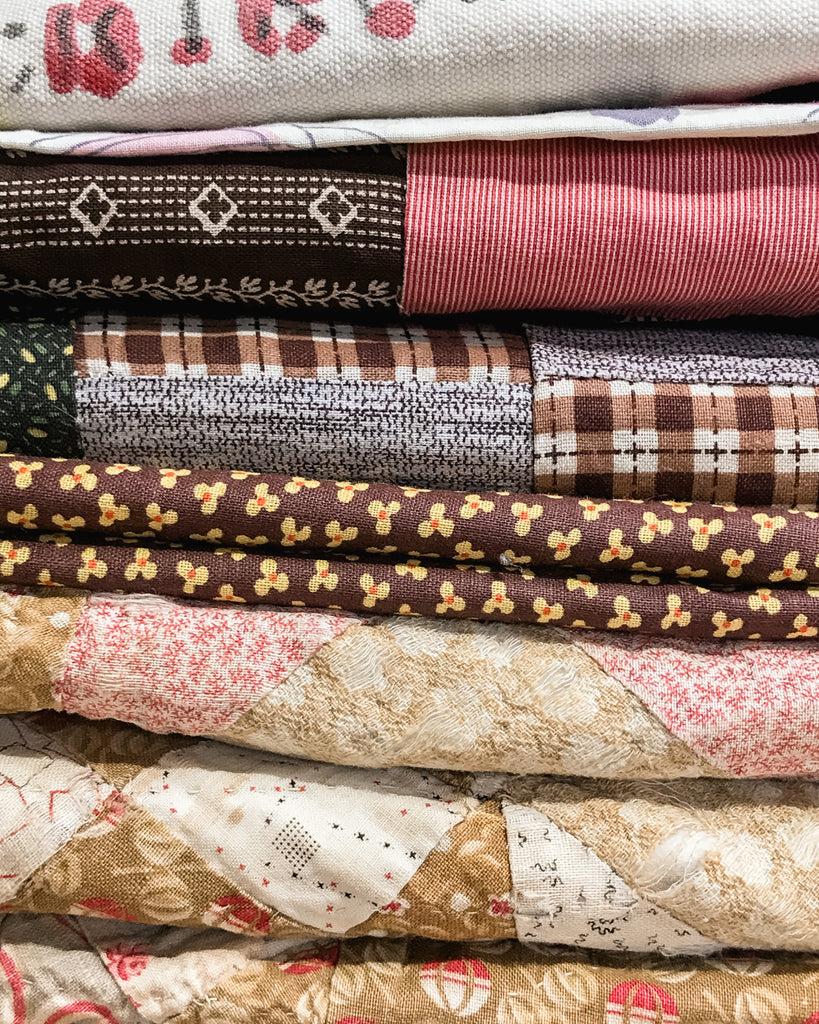
The 1800s quilt, well-loved, and in the colors of Pearl (our puppy!). The assortment of vintage textiles, including our two favourite antique quilts. 

This quilt was started in the 1930s and never finished – we transformed it into pouches lined with waxed canvas! This collection also contains one repurposed canvas tote that was originally designed with a drawstring closure – we’ve adapted it with vegetable-tanned leather straps and a waxed canvas pocket! Spring 2022 Of A Kind Collection
Our first Of A Kind Collection of 2022 is bursting with character! Each of these collections allows us to dig around and find treasures within treasures. Every discovery holds a bit of...
Read The Post -
I am sure my right arm* is stronger for all of the writing and stitching and hauling of pages in journals for so many years of my life. So many miles we’ve traveled together, me and my books. I wonder how many miles of words I’ve written if strung end to end? The first journal that I made was stolen in a café in Amsterdam. What the journal thief couldn’t possibly know was that his actions would set me upon a path.
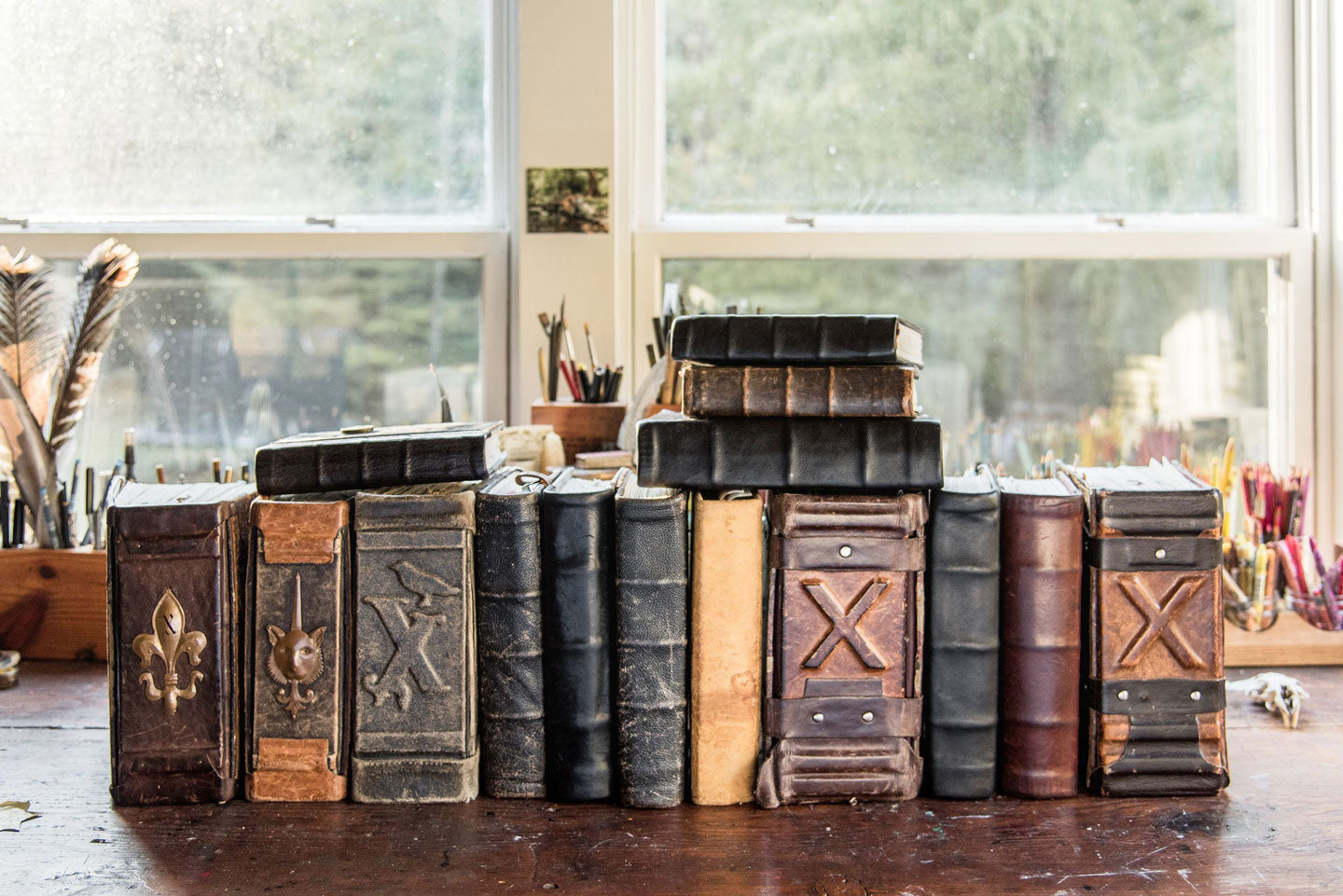

“Whatever you think you can do or believe you can do, begin it. Action has magic, grace, and power in it.”
–Johann Wolfgang GoetheI am sure my right arm* is stronger for all of the writing and stitching and hauling of pages in journals for so many years of my life. So many miles we’ve traveled together, me and my books. I wonder how many miles of words I’ve written if strung end to end? I've always made books (I have one from when I was 6!), but I began to keep a journal regularly when I was 12 years old, and started making my journals when I was 25. I won’t do the math, but there are a lot of years of books and a lot of years of scribbling between now and then. I was always stitching a book or filling one up.
Hunter S. Thompson invited me into his limo one day, outside of The Strand in NYC. Actually, it wasn’t me he invited in, but my journal—I was holding it. I didn’t know anything about Hunter beyond Fear and Loathing, but I climbed in and sat next to him—shoulder to shoulder. When he asked if he could see the journal, I handed it over. Then he asked if he could write in it. I said yes, of course. He wrote a message in Latin and I don’t remember what else. I never did get to translate it because I went to Amsterdam shortly after the encounter and my bag—with my journal in it—was stolen.
That was the first proper journal I had built. I’ve made hundreds since then. But the first one was stolen in a café in Amsterdam. What the journal thief couldn’t possibly know was that his actions would set me upon a path, for despite my initial despair, I struck out in search of a book bindery. After a day of walking and asking nearly every stranger I could make eye contact with about the shop, I’d finally found it. And what a magical place it was! I stocked up on supplies I’d never known existed then went to an upholstery shop up the street, where I discovered antique leather in a dusty floor corner removed from a chair made in the 1800s! With tools and material from the bindery, I set to work making my second journal, using my thighs as a book press. The result, with its battered old leather, looked like it had travelled through time many hundreds of years, and its pages begged for stories like that of The Journal Thief.
The very objects that started this adventure are a foundational piece of our shop. Putting these Tomes into production was no easy task and after much planning, many trials and many years, we’ve got the process down and have been able to explore with variations in headband, textiles, and leather! I appreciate everyone’s questions and interest in these Monsters!


Hand-stitched headbands adorn each Tome. I use all kinds of medium and make all kinds of marks within my journals! 

Working on sketches for Poison for Breakfast by Lemony Snicket! Harper and Jackson Tome Stack! Sign up for our newsletter if you haven’t already!
*since writing this, I've been using my left hand for drawing - beginning with the #100dayproject 2021! I'm still at it, so my left hand is catching up a little.
Handbound Leather Tomes
I am sure my right arm* is stronger for all of the writing and stitching and hauling of pages in journals for so many years of my life. So many...
Read The Post

















